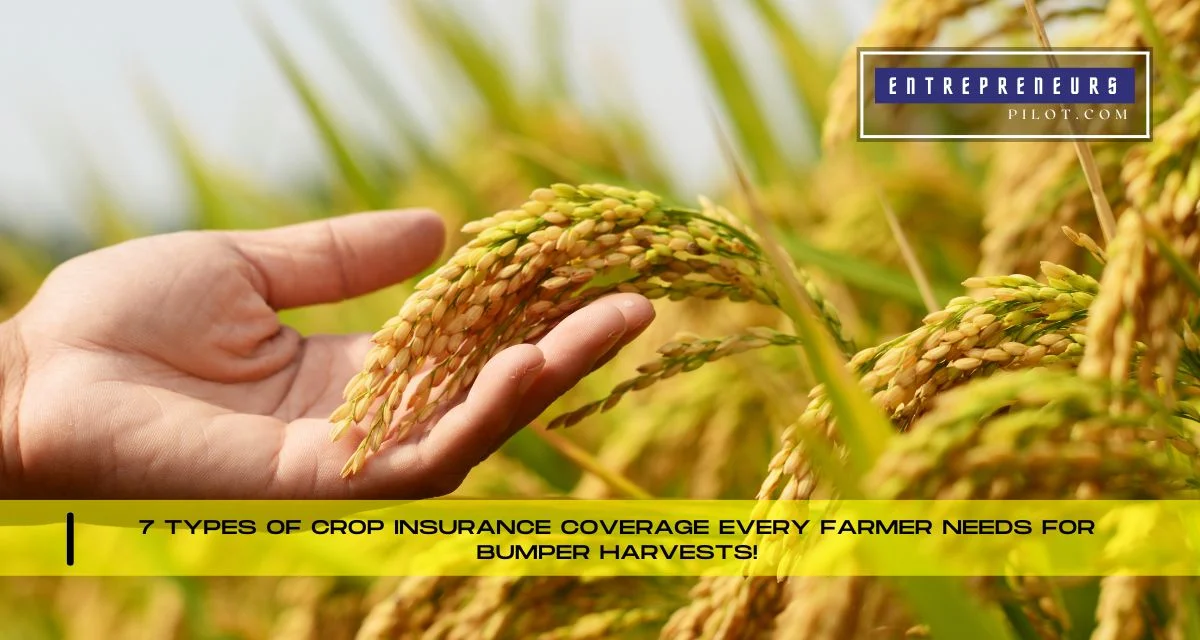Introduction
In the unpredictable world of farming, where the whims of weather can either make or break a season’s yield, safeguarding your hard work is not just smart—it’s essential. That’s where understanding the various Types Of Crop Insurance Coverage comes into play. Whether you’re tending to vast fields of grain or managing a boutique vineyard, the right insurance coverage can mean the difference between flourishing and floundering. This blog will walk you through seven critical types of crop insurance coverage every farmer needs to ensure those bumper harvests year after year. So, buckle up and get ready to arm yourself with knowledge that could save your livelihood and secure your future in agriculture.
Table of Contents
1. Multiple Peril Crop Insurance (MPCI)
Multiple Peril Crop Insurance (MPCI) is the bedrock of crop protection, offering coverage against a wide array of natural disasters such as drought, flood, hail, and more. This comprehensive policy is tailored to shield farmers from the unpredictable nature of weather and other perils that can devastate crops. With MPCI, you’re not just insuring your crops; you’re protecting your peace of mind throughout the growing season.
2. Crop-Hail Insurance
While MPCI covers a broad spectrum of risks, Crop-Hail Insurance focuses specifically on damage caused by hail—a frequent and often devastating occurrence in many farming regions. Hail can strike suddenly, decimating fields in minutes. This type of insurance is particularly valuable because it can be purchased at any time during the growing season, providing flexibility and immediate protection.
- For Expert Financial Insights And Guidance, You Can Visit Our Sister Site – ArabsGeek.com Now!
- Curiosity Piqued? Dive Into the Most Captivating Financial Content by Visiting Our Homepage!
- Unlock Exclusive Business Opportunities! 🚀 Connect with Us Now at our Email: [email protected]!
3. Revenue Protection Insurance
Revenue Protection Insurance goes beyond safeguarding the physical crop, offering a safety net for the financial outcome of your harvest. This coverage guarantees a certain level of revenue based on expected prices and yields, protecting against market volatility and crop failure. It’s an essential tool for financial planning and stability, ensuring that even if the crops don’t make it to harvest, your farm’s finances can still thrive.
4. Area Risk Protection Insurance (ARPI)
Area Risk Protection Insurance (ARPI) is designed for those who might be more concerned with regional disasters affecting large swathes of land. This policy pays out based on the average yield or revenue loss within a designated area, rather than individual farm output. ARPI is an excellent option for farmers in regions prone to widespread climatic or pest issues, offering a broader safety net.
5. Actual Production History (APH) Insurance
Actual Production History (APH) Insurance is tailored to the farmer’s specific history, offering coverage based on the individual’s average yield over several years. This personalized approach ensures that farmers are compensated if their production falls below their historical average, accounting for variability in individual performance and offering a custom-fit solution.
6. Whole-Farm Revenue Protection (WFRP)
Whole-Farm Revenue Protection (WFRP) is a comprehensive solution that covers all the produce of a farm under one policy, offering a holistic approach to insurance. This type is particularly appealing for diversified farms that grow multiple types of crops or incorporate livestock production. WFRP ensures that the total revenue of the farm is protected, making it a versatile and robust choice for modern, multifaceted agriculture operations.
7. Livestock Risk Protection (LRP)
While not directly a crop insurance, Livestock Risk Protection (LRP) is an essential coverage type for mixed farms that also manage livestock. LRP provides protection against market price downturns, ensuring that farmers receive a predetermined price for their animals, regardless of market fluctuations. This insurance type is crucial for those whose operations depend on both crop and livestock production, offering a comprehensive safety net across all facets of their business.
Choosing the Right Coverage
Selecting the right type of crop insurance coverage involves understanding your farm’s specific needs, risks, and financial goals. It’s about balancing the cost of premiums with the level of protection required to ensure your farm’s resilience in the face of adversity. Consulting with an insurance specialist who understands the intricacies of agricultural risks can provide invaluable guidance in this complex decision-making process.
Conclusion | Types Of Crop Insurance Coverage
As a farmer, the land is not just your workplace; it’s your legacy. Protecting it with the right Types Of Crop Insurance Coverage ensures that you can weather the storms, literal and figurative, that come your way. From the unpredictability of hail to the ebb and flow of market prices, being well-insured means you can focus on what you do best—growing the food that feeds the world. Remember, it’s not just about surviving; it’s about thriving, season after season.
Frequently Asked Questions
How do I know which type of crop insurance is right for my farm?
Consider your geographic location, types of crops grown, historical yield data, and financial stability. Consulting with an insurance agent who specializes in agricultural coverage can also help tailor a policy to your specific needs.
Can I have multiple types of crop insurance policies at once?
Yes, many farmers opt for a combination of policies to ensure comprehensive coverage. For example, you might choose MPCI for broad coverage and add Crop-Hail Insurance for specific risks.
How are crop insurance premiums determined?
Premiums are based on several factors, including the type of crop, acreage, level of coverage chosen, and historical yield data. Federal subsidies can also affect the final cost to the farmer.
What is the deadline for purchasing crop insurance?
Deadlines vary depending on the crop and insurance type. It’s crucial to consult with an insurance provider well before your growing season begins to ensure timely coverage.
Can crop insurance cover organic farms?
Yes, there are specific policies available for organic farms, which take into account the unique risks and higher value of organic produce. It’s essential to work with an insurer familiar with organic farming to get the best coverage.











